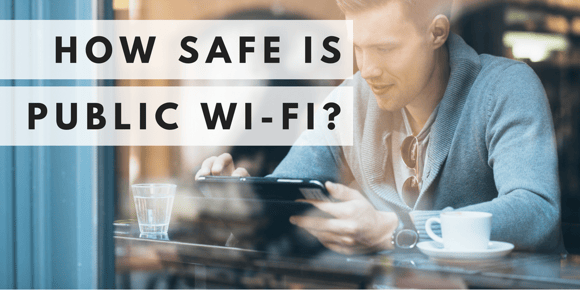The modern digital age is more convenient than ever. Not only can you walk around with a tiny supercomputer in the palm of your hand, you can use that supercomputer to connect to the entire world over the internet, with multiple options for network protocols. However, when it comes to the cybersecurity of your mobile devices and the data they contain, the entire world is often less risky than the person sitting at the restaurant table next to you.

Surfing the Unfriendly Airwaves
By the very nature of being public, openly accessible Wi-Fi connections remove many of the safeguards that you rely on to keep your data secure in your home and workplace.
Thanks to multiple public demonstrations and years of examination from security professionals, it's well known that it’s incredibly easy for hackers to compromise your devices and data when you’re connected to public Wi-Fi networks. Hackers can easily browse the internet traffic of other people connected to the same public network and can use that to deduce information about your banking activity, social network activity, and even your home address and movement patterns.
Hackers can even create fake networks that entice your mobile devices to connect automatically, allowing those hackers to send phony “updates” to users that automatically install malware. In the worst cases, that malware can contain key loggers that will copy your passwords and personal information as you type it, then send that information to the hacker. Indeed, public Wi-Fi is so easily compromised that even seven-year-olds can hack a public network in under 11 minutes.
Clearly the answer to the question “How safe is public Wi-Fi?” is, “Not at all, really.”
While you don’t need to completely give up the convenience and productivity provided by public networks, it’s important to establish good practices and habits for using them and educate your employees and coworkers accordingly. Here are a few tips to get started.
Thanks to multiple public demonstrations and years of examination from security professionals, it's well known that it’s incredibly easy for hackers to compromise your devices and data when you’re connected to public Wi-Fi networks. Hackers can easily browse the internet traffic of other people connected to the same public network and can use that to deduce information about your banking activity, social network activity, and even your home address and movement patterns.
Hackers can even create fake networks that entice your mobile devices to connect automatically, allowing those hackers to send phony “updates” to users that automatically install malware. In the worst cases, that malware can contain key loggers that will copy your passwords and personal information as you type it, then send that information to the hacker. Indeed, public Wi-Fi is so easily compromised that even seven-year-olds can hack a public network in under 11 minutes.
Clearly the answer to the question “How safe is public Wi-Fi?” is, “Not at all, really.”
While you don’t need to completely give up the convenience and productivity provided by public networks, it’s important to establish good practices and habits for using them and educate your employees and coworkers accordingly. Here are a few tips to get started.
1. Browse Securely and Use Encryption
One of the most effective ways to stay safe on a public network is to follow the best information security practices that you should be maintaining on any network, public or private.
The first of these is to browse secure websites whenever possible. Websites that begin with https:// operate with an encryption protocol that obscures the traffic you’re sending and receiving over the network, which provides some protection against third-party hacking. While https-secured websites won’t necessarily stop a determined hacker, they immediately make you a less tempting target than anybody around you who’s browsing an unsecured website, and that can be the difference between getting hacked or not.
Secondly, you should always ensure that your devices are set up to broadcast only encrypted signals whenever possible. Many mobile devices include features baked in to their software that will do this for you, but especially for businesses, it’s a good idea to work with a third-party partner to install and configure additional encryption measures on any device that might contain sensitive information.
 You can add an additional layer of encryption to your web surfing by only connecting to public networks that utilize a password-protected WPA network. Even when an establishment provides that password freely to its customers, the extra layer of security is another way to make you a less tempting target than the guy next to you who’s connected to a Wi-Fi network without a password.
You can add an additional layer of encryption to your web surfing by only connecting to public networks that utilize a password-protected WPA network. Even when an establishment provides that password freely to its customers, the extra layer of security is another way to make you a less tempting target than the guy next to you who’s connected to a Wi-Fi network without a password.
The first of these is to browse secure websites whenever possible. Websites that begin with https:// operate with an encryption protocol that obscures the traffic you’re sending and receiving over the network, which provides some protection against third-party hacking. While https-secured websites won’t necessarily stop a determined hacker, they immediately make you a less tempting target than anybody around you who’s browsing an unsecured website, and that can be the difference between getting hacked or not.
Secondly, you should always ensure that your devices are set up to broadcast only encrypted signals whenever possible. Many mobile devices include features baked in to their software that will do this for you, but especially for businesses, it’s a good idea to work with a third-party partner to install and configure additional encryption measures on any device that might contain sensitive information.
 You can add an additional layer of encryption to your web surfing by only connecting to public networks that utilize a password-protected WPA network. Even when an establishment provides that password freely to its customers, the extra layer of security is another way to make you a less tempting target than the guy next to you who’s connected to a Wi-Fi network without a password.
You can add an additional layer of encryption to your web surfing by only connecting to public networks that utilize a password-protected WPA network. Even when an establishment provides that password freely to its customers, the extra layer of security is another way to make you a less tempting target than the guy next to you who’s connected to a Wi-Fi network without a password.2. Use Two-Factor Authentication
Two-factor authentication adds an additional step to your login procedures for sites and programs that provide it. In a typical two-factor setup, you log in to the site using your password as normal, and then you’re sent a verification code via SMS text message, which must also be entered before your login is complete.
3. Don’t Use the Same Password
Bad password habits are a top reason that hackers are able to compromise a person’s entire digital identity. To maximize your safety, you should use a different password for each and every account that you have on any website or program. Keeping track of so many passwords can be difficult, so you may want to consider the use of a password management program, which will automatically keep track of your passwords and can provide additional layers of two-factor authentication and encryption when you need to sign in to something.
4. Ensure Software Is Updated
New security flaws and vulnerabilities are revealed every day, so it’s vital that you keep all your software up to date. It’s best to set all your programs to automatically update, especially any firewalls or antivirus programs. Additionally, vendor due diligence is necessary to make sure your third-party partners also maintain updated software.
5. Be a Smart Surfer
The best way to keep your information secure is not to access it in public locations to begin with. Be smart by only accessing bank accounts and other highly personal information at home, ideally on a desktop or other device that won’t ever be used to connect to public Wi-Fi.
While public Wi-Fi networks are most definitely not secure, you can still enjoy their convenience as long as you utilize the best security practices, avoid accessing high-value information and update your IT policies accordingly.
While public Wi-Fi networks are most definitely not secure, you can still enjoy their convenience as long as you utilize the best security practices, avoid accessing high-value information and update your IT policies accordingly.
Contact us today to find out how your organization can maximize the security of its mobile devices and public internet usage.



